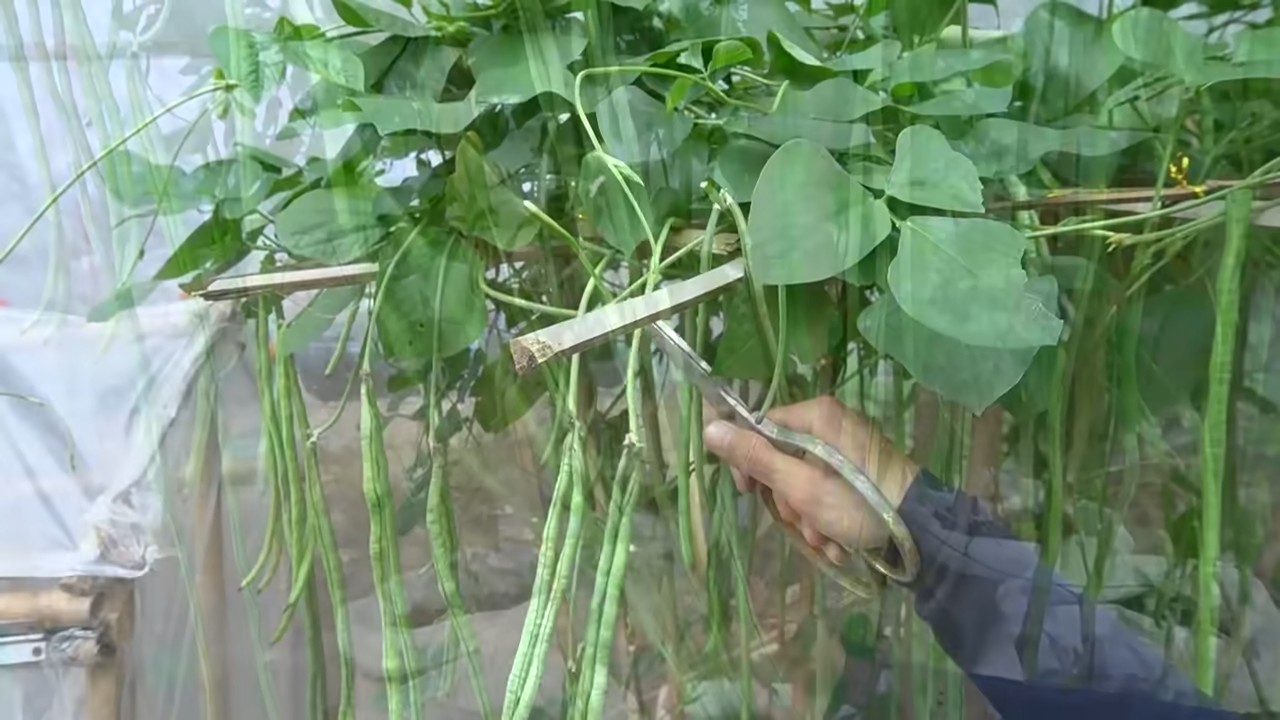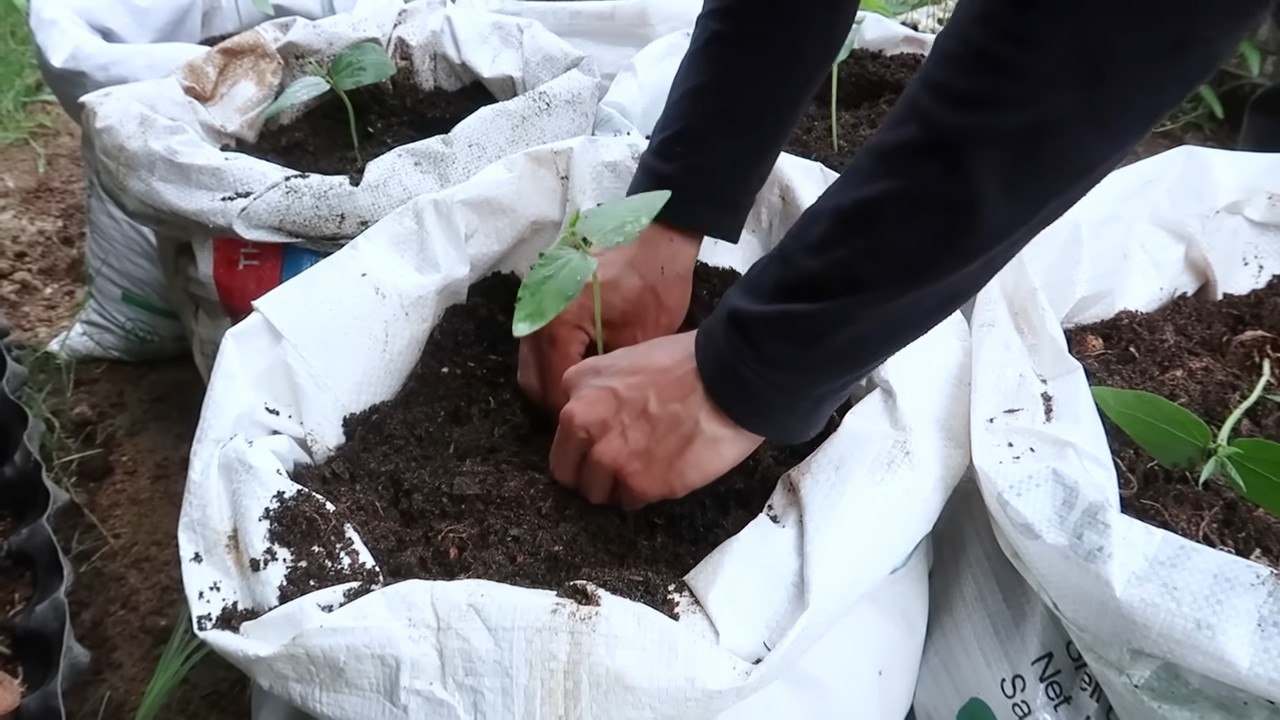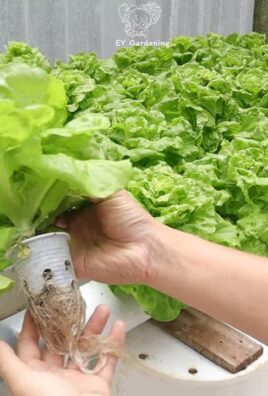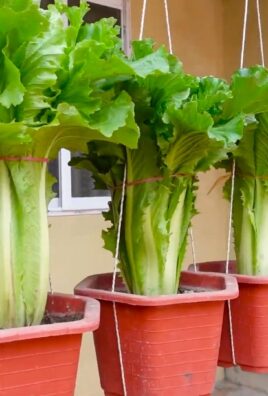Growing Long Beans in a Small Space can feel like a Herculean task, right? I get it! You dream of fresh, homegrown veggies, but your balcony looks more like a postage stamp than a sprawling farm. But don’t despair! This isn’t some impossible mission. I’m here to tell you that you *can* cultivate those delicious, lengthy legumes, even if you’re short on square footage.
For centuries, cultures around the globe have found ingenious ways to maximize their harvests, even in limited areas. Think of the hanging gardens of Babylon or the intricate terrace farming of the Incas – a testament to human ingenuity when faced with spatial constraints. The desire to nurture and provide, to connect with the earth, is deeply ingrained in us. And that desire shouldn’t be stifled by a lack of land!
That’s where these DIY tricks and hacks come in. Let’s face it, store-bought long beans just don’t compare to the vibrant flavor and satisfying crunch of those you’ve nurtured yourself. Plus, growing long beans in a small space is incredibly rewarding. Imagine the pride you’ll feel serving up a dish made with ingredients you’ve personally cultivated. This article is your guide to unlocking the secrets of vertical gardening, choosing the right varieties, and mastering the art of container cultivation. So, grab your gardening gloves, and let’s get started on your journey to a bountiful harvest, no matter how small your space!

Growing Long Beans in a Small Space: A DIY Vertical Garden Guide
Hey there, fellow gardening enthusiasts! Dreaming of fresh, homegrown long beans but short on space? Don’t worry, I’ve got you covered! I’m going to walk you through creating a simple, effective vertical garden that will have you harvesting delicious long beans in no time, even if you only have a balcony or small patio. This project is perfect for beginners and experienced gardeners alike. Let’s get started!
What You’ll Need
Before we dive into the nitty-gritty, let’s gather our supplies. Here’s a list of everything you’ll need to build your vertical long bean garden:
* Containers: Choose containers that are at least 12 inches deep and wide. Fabric pots, large plastic pots, or even repurposed buckets will work great. I personally love using fabric pots because they allow for better drainage and aeration. You’ll need at least two containers, but the more you have, the more beans you can grow!
* Potting Mix: Use a high-quality potting mix that’s well-draining and rich in organic matter. Avoid using garden soil, as it can compact and hinder root growth. I recommend a mix specifically formulated for vegetables.
* Long Bean Seeds: Select a long bean variety that suits your climate and preferences. Some popular choices include ‘Yard Long’, ‘Chinese Red Noodle’, and ‘Orient Wonder’.
* Trellis or Support Structure: Long beans are climbers, so they need a trellis or other support structure to grow vertically. You can use bamboo stakes, a metal trellis, netting, or even build your own DIY trellis. I’ll show you how to build a simple one later on.
* Twine or Plant Ties: To help train the vines to climb the trellis.
* Watering Can or Hose: For watering your plants.
* Fertilizer: A balanced fertilizer to provide essential nutrients.
* Gloves: To protect your hands.
* Hand Trowel: For planting the seeds.
* Measuring Tape: To measure and mark the trellis.
* Scissors or Pruning Shears: For trimming and harvesting.
* Optional: Mulch (straw, wood chips, or shredded leaves) to help retain moisture and suppress weeds.
Building a Simple DIY Trellis (Optional)
If you don’t have a trellis, don’t fret! Building one is easier than you think. Here’s how I make a simple and sturdy trellis using bamboo stakes and twine:
1. Gather Your Materials: You’ll need 4-6 bamboo stakes (depending on the size of your containers), twine, and scissors. The stakes should be tall enough to support the mature height of your long bean variety (usually 6-8 feet).
2. Position the Stakes: Insert the bamboo stakes into the soil around the perimeter of your container, spacing them evenly. Make sure they are securely anchored in the soil.
3. Create Horizontal Supports: Starting near the bottom of the stakes, tie twine horizontally between each stake, creating a grid-like pattern. Space the horizontal supports about 6-8 inches apart.
4. Secure the Twine: Tie the twine tightly to each stake, using a simple knot like a square knot or a clove hitch.
5. Add Diagonal Supports (Optional): For extra stability, you can add diagonal supports by tying twine diagonally between the stakes.
6. Test the Trellis: Gently push and pull on the trellis to make sure it’s sturdy and can support the weight of the long bean vines.
Planting Your Long Bean Seeds
Now for the fun part – planting! Here’s how I plant my long bean seeds for optimal growth:
1. Prepare the Containers: Fill your containers with the potting mix, leaving about an inch of space at the top.
2. Sow the Seeds: Sow the long bean seeds directly into the potting mix, spacing them about 2-3 inches apart. Plant them about 1 inch deep. I usually plant 3-4 seeds per container to ensure good germination.
3. Water Gently: Water the soil gently after planting, making sure to moisten the entire surface. Avoid overwatering, as this can cause the seeds to rot.
4. Provide Warmth: Long beans prefer warm temperatures for germination. If you’re starting them indoors, place the containers in a warm location or use a heat mat.
5. Wait for Germination: Long bean seeds typically germinate within 7-14 days, depending on the temperature and moisture levels. Keep the soil consistently moist during this time.
Caring for Your Long Bean Plants
Once your long bean seedlings emerge, it’s time to provide them with the care they need to thrive. Here’s what I do to keep my long bean plants happy and productive:
1. Watering: Water your long bean plants regularly, especially during hot and dry weather. Check the soil moisture by sticking your finger into the soil. If the top inch feels dry, it’s time to water. Avoid overwatering, as this can lead to root rot. I usually water deeply and less frequently, rather than shallowly and more often.
2. Sunlight: Long beans need at least 6-8 hours of sunlight per day to produce a good harvest. Place your containers in a sunny location where they will receive plenty of direct sunlight.
3. Fertilizing: Feed your long bean plants with a balanced fertilizer every 2-3 weeks. Follow the instructions on the fertilizer package. I like to use a liquid fertilizer diluted in water. You can also amend the soil with compost or other organic matter to provide essential nutrients.
4. Training the Vines: As the long bean vines grow, gently train them to climb the trellis. Use twine or plant ties to secure the vines to the trellis if needed. This will help them grow vertically and prevent them from sprawling on the ground.
5. Pruning: Prune away any yellowing or dead leaves to improve air circulation and prevent disease. You can also pinch off the tips of the vines to encourage branching and bushier growth.
6. Pest and Disease Control: Keep an eye out for pests and diseases, such as aphids, spider mites, and fungal infections. If you notice any problems, take action promptly. You can use insecticidal soap, neem oil, or other organic pest control methods. For fungal diseases, improve air circulation and avoid overwatering.
7. Mulching: Apply a layer of mulch around the base of the plants to help retain moisture, suppress weeds, and regulate soil temperature. Straw, wood chips, or shredded leaves work well as mulch.
Harvesting Your Long Beans
The moment you’ve been waiting for – harvesting your homegrown long beans! Here’s how I harvest my long beans for the best flavor and texture:
1. Timing: Long beans are typically ready to harvest about 60-70 days after planting. Harvest them when they are young and tender, before the seeds inside become too large and tough. The pods should be firm and snap easily when bent.
2. Technique: Use scissors or pruning shears to cut the long beans from the vine. Be careful not to damage the plant.
3. Frequency: Harvest your long beans regularly, every few days, to encourage continued production. The more you harvest, the more beans the plant will produce.
4. Storage: Store your harvested long beans in the refrigerator for up to a week. They are best eaten fresh, but you can also freeze them for longer storage.
Troubleshooting Common Problems
Even with the best care, you might encounter some challenges along the way. Here are some common problems and how I address them:
* Poor Germination: If your long bean seeds aren’t germinating, make sure the soil is warm and consistently moist. You can also try soaking the seeds in water for 24 hours before planting to improve germination rates.
* Yellowing Leaves: Yellowing leaves can be a sign of nutrient deficiency, overwatering, or pest infestation. Check the soil moisture and fertilize if needed. Inspect the plants for pests and treat accordingly.
* Lack of Flowers or Pods: If your long bean plants are growing well but not producing flowers or pods, it could be due to insufficient sunlight, lack of pollination, or nutrient deficiency. Make sure the plants are getting enough sunlight and fertilize with a balanced fertilizer. You can also try hand-pollinating the flowers by gently transferring pollen from one flower to another using a small brush.
* Pest Infestations: Pests like aphids and spider mites can damage long bean plants. Inspect the plants regularly and treat any infestations promptly with insecticidal soap, neem oil, or other organic pest control methods.
* Fungal Diseases: Fungal diseases like powdery mildew can affect long bean plants, especially in humid conditions. Improve air circulation by pruning away crowded leaves and avoid overwatering. You can also use a fungicide if necessary.

Conclusion
So, there you have it! Growing long beans in a small space isn’t just a possibility; it’s a rewarding and surprisingly simple endeavor. We’ve walked through the key steps, from selecting the right variety and preparing your containers to providing essential support and nurturing your plants. But why should you take the plunge and dedicate your precious patio or balcony space to these fascinating legumes?
The answer is multifaceted. Firstly, the sheer satisfaction of harvesting your own fresh produce is unparalleled. Imagine stepping outside your door and picking crisp, vibrant long beans for your stir-fries, salads, or even a simple side dish. The flavor is undeniably superior to anything you can find in a supermarket, bursting with freshness and a subtle sweetness that only homegrown vegetables possess.
Secondly, growing long beans is an incredibly efficient way to maximize your limited space. Their vertical growth habit means they take up minimal ground area while yielding a substantial harvest. This makes them ideal for balconies, patios, and even small urban gardens where every square inch counts. Think of it as a green wall that also feeds you!
Thirdly, it’s a fantastic learning experience. Gardening, even on a small scale, connects you with nature and teaches you about the life cycle of plants. You’ll gain a deeper appreciation for the food you eat and the effort it takes to produce it. Plus, it’s a wonderfully relaxing and therapeutic activity that can help reduce stress and improve your overall well-being.
But the benefits don’t stop there. Growing your own food is also a sustainable choice. You’re reducing your reliance on commercially grown produce, which often travels long distances and contributes to carbon emissions. You’re also avoiding the use of harmful pesticides and herbicides, ensuring that your food is healthy and safe for you and your family.
Ready to take your long bean growing to the next level? Consider experimenting with different varieties to find your favorite flavor and texture. Try adding companion plants like marigolds or basil to deter pests and attract beneficial insects. You can also explore different trellising methods to create a visually stunning and productive vertical garden.
And don’t be afraid to get creative with your containers! Upcycle old buckets, crates, or even fabric grow bags to create a unique and personalized growing space. The possibilities are endless!
We wholeheartedly encourage you to give this DIY trick a try. It’s a fun, rewarding, and sustainable way to enjoy fresh, delicious long beans, even if you only have a small space to work with. Once you taste the difference between homegrown and store-bought, you’ll be hooked!
So, grab your seeds, prepare your containers, and get ready to embark on a long bean growing adventure. And most importantly, don’t forget to share your experiences with us! We’d love to hear about your successes, your challenges, and any tips or tricks you discover along the way. Share your photos and stories on social media using [Your Hashtag] and let’s inspire others to embrace the joy of growing their own food, one long bean at a time. Let’s see how many people we can get **growing long beans** in small spaces!
Frequently Asked Questions (FAQ)
What is the best variety of long bean to grow in a small space?
Choosing the right variety is crucial for success. Bush-type long beans are generally more compact and suitable for containers than pole beans, which require extensive trellising. However, even pole beans can thrive in small spaces with proper support. Look for varieties specifically bred for container gardening or those known for their shorter vine length. Some popular choices include ‘Yardlong’ (a classic pole bean), ‘Chinese Red Noodle’ (known for its vibrant color), and bush bean varieties specifically labeled as suitable for containers. Researching the specific growth habits of each variety before planting will help you make the best choice for your available space.
How much sunlight do long beans need?
Long beans are sun-loving plants and require at least 6-8 hours of direct sunlight per day to thrive. I
So, there you have it! Growing long beans in a small space isn’t just a possibility; it’s a rewarding and surprisingly simple endeavor. We’ve walked through the key steps, from selecting the right variety and preparing your containers to providing essential support and nurturing your plants. But why should you take the plunge and dedicate your precious patio or balcony space to these fascinating legumes?
The answer is multifaceted. Firstly, the sheer satisfaction of harvesting your own fresh produce is unparalleled. Imagine stepping outside your door and picking crisp, vibrant long beans for your stir-fries, salads, or even a simple side dish. The flavor is undeniably superior to anything you can find in a supermarket, bursting with freshness and a subtle sweetness that only homegrown vegetables possess.
Secondly, growing long beans is an incredibly efficient way to maximize your limited space. Their vertical growth habit means they take up minimal ground area while yielding a substantial harvest. This makes them ideal for balconies, patios, and even small urban gardens where every square inch counts. Think of it as a green wall that also feeds you!
Thirdly, it’s a fantastic learning experience. Gardening, even on a small scale, connects you with nature and teaches you about the life cycle of plants. You’ll gain a deeper appreciation for the food you eat and the effort it takes to produce it. Plus, it’s a wonderfully relaxing and therapeutic activity that can help reduce stress and improve your overall well-being.
But the benefits don’t stop there. Growing your own food is also a sustainable choice. You’re reducing your reliance on commercially grown produce, which often travels long distances and contributes to carbon emissions. You’re also avoiding the use of harmful pesticides and herbicides, ensuring that your food is healthy and safe for you and your family.
Ready to take your long bean growing to the next level? Consider experimenting with different varieties to find your favorite flavor and texture. Try adding companion plants like marigolds or basil to deter pests and attract beneficial insects. You can also explore different trellising methods to create a visually stunning and productive vertical garden.
And don’t be afraid to get creative with your containers! Upcycle old buckets, crates, or even fabric grow bags to create a unique and personalized growing space. The possibilities are endless!
We wholeheartedly encourage you to give this DIY trick a try. It’s a fun, rewarding, and sustainable way to enjoy fresh, delicious long beans, even if you only have a small space to work with. Once you taste the difference between homegrown and store-bought, you’ll be hooked!
So, grab your seeds, prepare your containers, and get ready to embark on a long bean growing adventure. And most importantly, don’t forget to share your experiences with us! We’d love to hear about your successes, your challenges, and any tips or tricks you discover along the way. Share your photos and stories on social media using [Your Hashtag] and let’s inspire others to embrace the joy of growing their own food, one long bean at a time. Let’s see how many people we can get **growing long beans** in small spaces!
Frequently Asked Questions (FAQ)
What is the best variety of long bean to grow in a small space?
Choosing the right variety is crucial for success. Bush-type long beans are generally more compact and suitable for containers than pole beans, which require extensive trellising. However, even pole beans can thrive in small spaces with proper support. Look for varieties specifically bred for container gardening or those known for their shorter vine length. Some popular choices include ‘Yardlong’ (a classic pole bean), ‘Chinese Red Noodle’ (known for its vibrant color), and bush bean varieties specifically labeled as suitable for containers. Researching the specific growth habits of each variety before planting will help you make the best choice for your available space.
How much sunlight do long beans need?
Long beans are sun-loving plants and require at least 6-8 hours of direct sunlight per day to thrive. Insufficient sunlight can lead to stunted growth, reduced yields, and increased susceptibility to pests and diseases. If you’re growing long beans indoors or in a partially shaded area, consider supplementing with grow lights to ensure they receive adequate light. Observe your plants closely and adjust their position as needed to maximize their exposure to sunlight.
What kind of soil is best for growing long beans in containers?
Long beans prefer well-draining, fertile soil that is rich in organic matter. A good potting mix specifically formulated for vegetables is ideal. Avoid using garden soil in containers, as it can become compacted and poorly drained. You can also amend your potting mix with compost, aged manure, or other organic materials to improve its fertility and drainage. Ensure the pH of the soil is slightly acidic to neutral (around 6.0-7.0) for optimal growth.
How often should I water my long beans?
Watering frequency depends on several factors, including the weather, the size of your container, and the type of soil you’re using. Generally, long beans need to be watered regularly, especially during hot, dry periods. Check the soil moisture level daily by sticking your finger into the soil. If the top inch feels dry, it’s time to water. Water deeply until the water drains out of the bottom of the container. Avoid overwatering, as this can lead to root rot.
Do long beans need fertilizer?
Yes, long beans benefit from regular fertilization, especially during their active growing season. Use a balanced fertilizer specifically formulated for vegetables, following the instructions on the label. You can also use organic fertilizers like compost tea or fish emulsion. Avoid over-fertilizing, as this can lead to excessive foliage growth at the expense of bean production.
How do I support my long bean plants?
Long beans are climbing plants and require support to grow properly. You can use a trellis, stakes, netting, or even a fence to provide support. The type of support you choose will depend on the variety of long bean you’re growing and the size of your container. Ensure the support is sturdy enough to withstand the weight of the mature plants and the beans. Train the vines to climb the support as they grow, tying them loosely with twine or plant clips if necessary.
When can I harvest my long beans?
Long beans are typically ready to harvest about 60-90 days after planting, depending on the variety. Harvest the beans when they are young and tender, before the seeds inside become too large and tough. The beans should be firm and snap easily when bent. Harvest regularly to encourage continued production.
What are some common pests and diseases that affect long beans?
Long beans can be susceptible to various pests and diseases, including aphids, bean beetles, spider mites, and fungal diseases like powdery mildew. Monitor your plants regularly for signs of infestation or disease. Use organic pest control methods like insecticidal soap, neem oil, or diatomaceous earth to control pests. Ensure good air circulation and avoid overwatering to prevent fungal diseases.
Can I grow long beans indoors?
While it’s possible to grow long beans indoors, it can be challenging due to the need for ample sunlight and space. If you choose to grow long beans indoors, provide them with at least 6-8 hours of direct sunlight per day or supplement with grow lights. Use a large container and provide adequate support for the vines. Be prepared to hand-pollinate the flowers if necessary.
How can I save seeds from my long beans?
Saving seeds from your long beans is a great way to ensure you have a supply of seeds for future plantings. Allow some of the beans to mature fully on the vine, until they are dry and brown. Remove the seeds from the pods and allow them to dry completely before storing them in an airtight container in a cool, dark place. Be aware that seeds saved from hybrid varieties may not produce plants that are true to type.




Leave a Comment